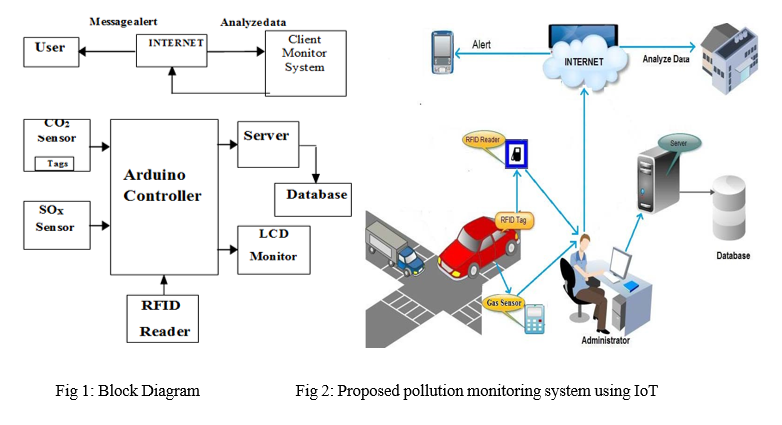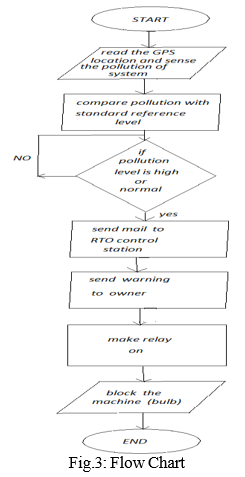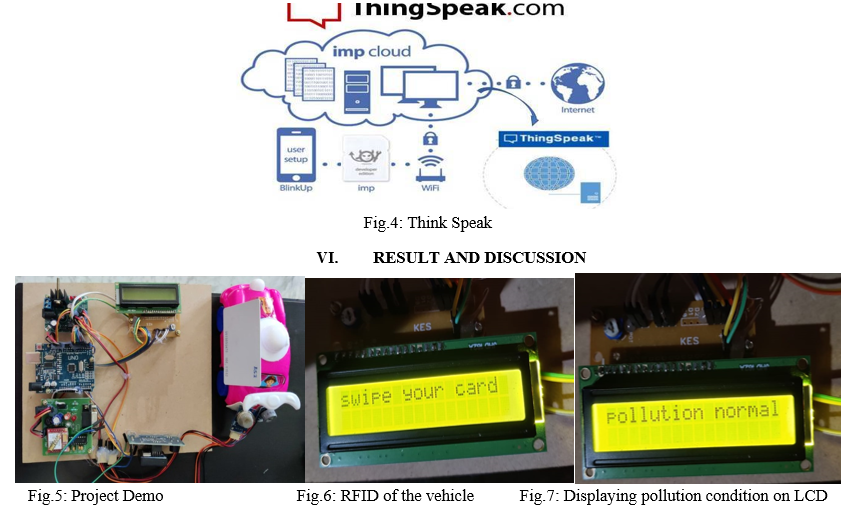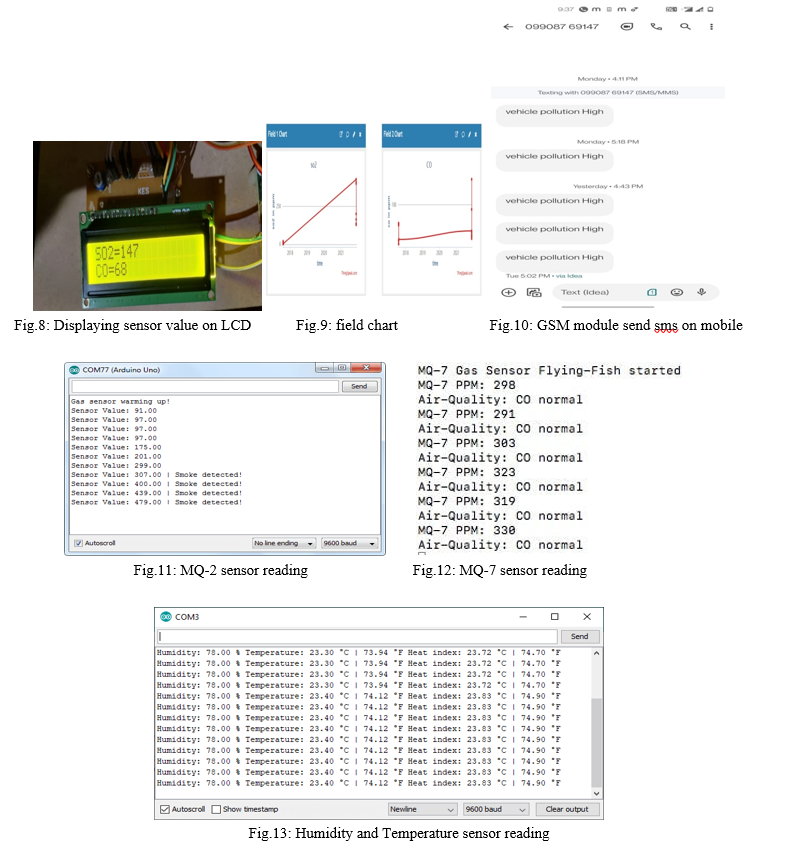Ijraset Journal For Research in Applied Science and Engineering Technology
- Home / Ijraset
- On This Page
- Abstract
- Introduction
- Conclusion
- References
- Copyright
Vehicular Pollution Monitoring Using IOT
Authors: Sampada N. Lolge, Mrs. S. D. Sanap
DOI Link: https://doi.org/10.22214/ijraset.2021.39270
Certificate: View Certificate
Abstract
The air quality in metropolises is demeaning as a result of a complex commerce between natural and artificial environmental conditions. With the increase in urbanization and industrialization and lack of control on emigrations and use of catalytic transformers, a great quantum of particulate and poisonous feasts is produced. The ideal of this design is to cover air pollution on roads and track vehicles which beget pollution over a specified limit. Increased use of motorcars is a serious problem that has been around for a veritably long time. This paper gives check of different systems used to cover vehicular pollution and proposes use of Internet of Effects (IoT) to address this problem. Then, combination of Poisonous Gas Detectors and Radio Frequency Identification (RFID) trailing system is used to cover vehicular pollution records anytime anywhere.
Introduction
I. INTRODUCTION
The content of this paper is grounded on the problem that the society is facing currently.[1] Pollution continues to be a significant issue for our terrain.[2] The adulterants from vehicles can impact the atmosphere in a variety of ways.[3] This design suggests a precious route for seeing machine emigrations, particularly CO gas emigrations. This involves Gas detector to identify Motor Vehicle Pollution. [4] This helps to track the data in real time and with low costs.[5] The vehicle proprietor can identify the emigration position fluently in advance.[6] We used Thinkspeak cloud to store the data and to read the data at any time.[7]
The end of this system is to produce a compact vehicle contaminant discovery tool that could be mounted on the vehicle itself and to reduce the CO emigration in the atmosphere. [8]The bank rate emitted from the vehicle is covered by detectors, and the data can be displayed on the vehicle proprietor's phone, [9] which can be displayed to officers when asked about the vehicle's emigrations report, for illustration, when they visit the hill station. [10]
Arduino Board- Acts as a board for integrating the detector and GSM.[11] Global System for Mobile Dispatches-It gets the data from Thinkspeak Cloud and transferred the alert communication to the specific stoner if the CO emigration position from the vehicle crosses the needed threshold position.[12] It also shows the data in stoner's phone's Android operation. MQ7 Gas Sensor- To descry the emigration of Carbon monoxide from vehicles. [13]
We used IoT technology that's fleetly adding in moment's script.[14] IoT is used in all sectors currently. With the help of this technology, mortal intervention can be used. [15]
Radio frequence identification (RFID) technology has been in use for decades.[16] Only lately, lower cost and increased capabilities made RFID technology to be a commercially feasible bone.[17] RFID emerges as one of the clustering technologies and crucial catalyst playing a significant part in this exploration work.[18] This paper aims to understand the utility of RFID technology to descry.[19] Gas detector technologies are still developing and have yet to reach their full eventuality in capabilities and operation.[20] Some technologies are veritably accurate but also veritably precious for large-scale deployment.[21] On the other hand, with the use of detector network, low cost technologies can be used and the problem of false cons can potentially be reduced with the help of multifariousness in data.[22] Large number of labors collected from individual detectors can be compared for a more accurate analysis. Therefore, wireless detector networks offer important new ways to cover air quality.[23]
II. LITERATURE SURVEY
The information about the situations of CO2 and SOx, vehicular number, RFID of the vehicle and time and date of vehicle are also transferred to the garçon of the authorized agencies. [1] This information is stored in the garçon database for unborn analysis. In this system using wireless detector network that provides a frame for collecting the detector data at any place using IoT. [2]
Wireless detector along with active RFID is used in the proposed wireless detector system to cover the vehicular pollution grounded on IoT.[3] Pollution data is displayed on LCD & Communication alert transferred to vehicle proprietor for exceeding pollution position.[4] Another proposed system consists of two modules vehicle unit and remote monitoring unit. [5] Vehicle units, which resides in a vehicle consists of CO2, LPG GAS detectors, RFID markers and GSM modem. Remote monitoring garçon area holds the garçon unit, GSM modem and Laptop. [6]
XAMPP is used as original host garçon to view the Arduino contents in the remote area of garçon.[7] From the proposed system, a low cost RFID grounded operation can be designed using Arduino and the operations of Home robotization, Artificial control, Transportation can be achieved fluently. [8]The vehicle unit periodic monitoring of the detector values are noted and shoot to the
laptop via GSM modem.[9] Along with the Detector values, Vehicle FC details, Insurance Details, Periodic Service details are viewed on the laptop using VB.[10] However, FC, Service an alert will be shooting to the proprietor, If any increase in the detector readings/ Date expired of any insurance.[11] A compact system can be developed to descry the adulterants in the vehicle which could be assembled in the vehicle itself.[12] Tremendous inventions have been made in the technology and manufacturing of buses as well as in the pollution control department but still nothing significant achieved of it.[13]
This idea employs an MQ7 detector which is provident and able of detecting Carbon Monoxide gas emitted from the vehicle. [14] An original warning is given to the motorist regarding the quantum of CO gas with the help of TV display and latterly the same information is transferred to the Pollution Control Board in case of negligence.[15] This is done with the help of GSM system incorporated in the vehicle. The AVR Microcontroller is used to transfer the information to the GSM system from the MQ7 detector. [16] This paper is able to measure the value of adulterants emitted by the vehicle continuously and display it on 16x2 alphanumeric TV display. Also if the pollutant position exceeds the prescribed value, also a SMS will be transferred to the separate authority to take necessary correctional action. [17]
The main component of the project is the TSOP1738 receiver. It is a 3 pin tool in which the 3 pins are GND, VS and OUTPUT. The VS pin is attached to the 5V supply. [18] The output pin is connected to pin 11 of Arduino UNO. We are using a 4-channel relay module in this project in order to control 4 different loads. Since the board has all of the vital additives like transistors, LEDs etc. All we want to do is to attach the four inputs at the relay board to four virtual I/O pins of Arduino. More distinctive connection may be discovered with inside the circuit diagram. [19]Home automation is an in call for idea in which an unmarried tool will manage exclusive home equipment of a home. Additionally, distinct factors like temperature, humidity, safety etc. also can be monitored the usage of that device. [20]
In this project, a simple home automation system where the system controls 4 different appliances with the help of a TV Remote. The operating of the task is defined here. [21] The main component of the project is TSOP1738 IR Receiver Module. This module has a built – in photo receiver, band pass filter and demodulator and the output of the module can be readily read by a microcontroller. TSOP1738 helps a service frequency of 38 KHz. [22] Hence, the carrier frequency of the source i.e. the remote control must be in the range of 38 KHz for it to demodulate. We will decode the information from the far flung manage the usage of TSOP1738 and Arduino UNO. For that, we need to use a special library called “IR remote”. [23]
III. PROPOSED SYSTEM

The model of the proposed system uses IoT to address vehicular pollution in real- time operations. Two gas detectors CO2, SOx is used to cover the adulterants continuously to maintain the quality of the air. The block diagram of the proposed air pollution monitoring system is shown in Fig 1.
At examiner position, the RFID anthology, wireless gas detectors are integrated along with the microcontroller. This entire system is placed on either of the roads. Whenever the vehicles equipped with RFID markers passed through the detector knot, the RFID anthology presented in the monitoring system detects the vehicles and the detectors measure the quality of the air produced by that vehicle. The tasted nonstop data is transferred to the microcontroller for verification of the pollution position of the vehicle. The microcontroller verifies the situations of the adulterants in the air produced by the vehicle. However, also it sends a warning communication to the vehicle proprietor If the adulterants situations are beyond the threshold situations. The same data is displayed on the Liquid Crystal Display (TV). The details about the situations of CO2 and SOx, vehicular number, RFID of the vehicle, and time and date of the vehicle are also transferred to the garçon of the authorized agencies. This information is stored in the garçon database for unborn analysis. The real-time monitoring of vehicular pollution systems using IoT.
IV. FLOW CHART

When we started the system, first we read the GPS position in the form of latitude and longitude. After that using gas detector MQ135 sense the pollution ranges of the system. This pollution ranges compared with standard reference position. If pollution position is advanced than standard value also shoot correspondence to RTO control station additional pollution position is normal also continuously compare pollution with standard reference position until our pollution ranges changes. After that shoot warning to proprietor if the proprietor won't response the correspondence also RTO or the control station will make relay on and block the machine. Then we've used bulb as a machine.
V. HARDWARE USE
- Arduino: Arduino is an open- source electronics platform predicated on easy-to- use attack and software. Arduino boards are suitable to read inputs- light on a sensor, a croquette on a button, or a Twitter communication-and turn it into an affair- twiddling a motor, turning on an LED, publishing commodity online. Arduino Uno is a microcontroller board predicated on the ATmega328P (datasheet). The arduino has 14 digital input/ affair legs (of which 6 can be used as PWM labors), 6 analog inputs, a 16 MHz ceramic resonator (CSTCE16M0V53-R0), a USB connection, a power jack, an ICSP title and a reset button.
- GSM Modem (800L): The SIM800L is a GSM module from Simcom that gives any microcontroller GSM functionality, meaning it can connect to the mobile network to admit calls and shoot and admit textbook dispatches, and also connect to the internet using GPRS, TCP, or IP. Another advantage is that the board makes use of being mobile frequentness, which means it can be used anywhere in the world.
- MQ2 Gas Sensor: The MQ-2 Gas sensor can descry or measure feasts like LPG, Alcohol, Propane, Hydrogen, CO, and indeed methane. The module interpretation of this sensor comes with a Digital Leg which makes this sensor to operate indeed without a Microcontroller and that comes in handy when you are only trying to descry one particular gas. When it comes to measuring the gas in ppm the analog leg has to be used, the analog leg also TTL driven and works on 5V and hence can be used with utmost common microcontrollers. So if you are looking for a sensor to descry or measure feasts like LPG, Alcohol, Propane, Hydrogen, CO and indeed methane with or without a microcontroller.
- MQ-135: The MQ-135 Gas detectors are used in air quality control accoutrements and are suitable for detecting or measuring of NH3, NOx, Alcohol, Benzene, Bank, CO2. The MQ-135 detector module comes with a Digital Leg which makes this detector to operate indeed without a microcontroller and that comes in handy when you're only trying to descry one particular gas. However, the analog leg needs to be used, if you need to measure the feasts in PPM. The analog leg is TTL driven and works on 5V and so can be used with utmost common microcontrollers.
- LCD Display: LCD modules are very commonly used in most embedded projects, the reason being their cheap price, availability, and programmer-friendly.
- RFID Reader Card: The EM-18 RFID Anthology module operating at 125 kHz is an affordable result for your RFID- grounded operation. The Anthology module comes with an on- chip antenna and can be powered up with a 5V power force. Power up the module and connect the transmit leg of the module to admit the leg of your microcontroller. Show your card within the reading distance and the card number is thrown at the affair. Voluntarily the module can be configured for also a Weigand affair.
- ThinkSpeak: ThingSpeak is open- source software written in Ruby which allows druggies to communicate with internet enabled bias. It facilitates data access, reclamation and logging of data by furnishing an API to both the bias and social network websites. ThingSpeak was firstly launched by iot Bridge in 2010 as a service in support of IoT operations. ThingSpeak has integrated support from the numerical computing software MATLAB from MathWorks, allowing Thing Speak druggies to dissect and fantasize uploaded data using MATLAB without taking the purchase of a MATLAB license from Math Works.

This is vehicular pollution monitoring using an IoT system. This is the original state. On TV display pollution ranges of the system and latitude, longitude is displayed. The Arduino- grounded pollution monitoring system is developed and the performance of the advanced system is vindicated successfully for colorful vehicles. The enrollment number of the vehicle fitted with an RFID label and passed through the monitoring system is linked using an active RFID receiver and is displayed on the TV. Fig 6 shows the display of the vehicle number that passes through the monitoring system with an RFID label. The monitoring system displays the adulterants situations of the vehicle and is shown in Fig 7. The regulator sends the details of the vehicle and the contaminant values to the garçon for covering the pollution situations of the vehicle.

Conclusion
The proposed system of covering the pollution will reduce the air pollution. This paper gives the fashion for vehicular pollution monitoring using IoT. This paper helps to study the being systems and development for IoT. This paper presented the design and development of IoT grounded vehicular pollution monitoring system for green revolution. The tackle armature and software perpetration are bandied in length. The performance of the system is also vindicated using IoT technology. The designed smart intelligent environmental system monitors the adulterants produced by the vehicles and also advise the vehicle possessors to control the pollution. The system also sends the pollutant position data to the garçon for unborn analysis. The air pollution agencies can suitable to dissect the data and also descry the vehicle enrollment figures that causes further pollution in the atmosphere. The advanced system is a low cost, simple to operate and is fluently fitted in any locales. The advanced system provides better delicacy with low cost than the being system.
References
[1] Famesh D. Thakre , Bidyut K. Talukdar, Gaurav S. Gosavi , Prashant R. Tayade, “Minimization of CO & CO2 from Exhaust of Two Wheeler Motorcycle”, Vol. 4, Special Issue 3, January 2017. [2] Y. J. Jung, Y. K. Lee, D. G. Lee, K. H. Ryu, and S. Nittel, “Air pollution monitoring system based on geosensor network”, in Proc. IEEE Int. Geoscience Remote Sensing Symp., 2008, vol. 3, pp. 1370- 1373. [3] Abu Jayyab, S. Al Ahdab, M. Taji, Z. Al Hamdani, F. Aloul, “Pollumap: Air Pollution mapper for cities”, in Proc. IEEE Innovations in Information Technology Conf., Dubai, UAE, Nov.2006, pp.1-5 [4] A.Kadri, E. Yaacoub, M. Mushtaha, And A. Abu-Dayya, “Wireless Sensor Network For Real-Time Airpollutionmonitoring,” In Proceedings Of IEEE International Conference On Communications, Signalprocessing And Their Applications, February 2013, Pp. 1-5. [5] D.D.Lee and D.S.Lee, ”Environmental gas sensors”,IEEE sensors J.,vol.1,no.3,pp.214-215,Oct. 2001 [6] NihalKularatna, Senior Member, IEEE, and B. H. Sudantha, Member, IEEE “An Environment Air Pollution Monitoring System Based on the IEEE1451 Standard for Low Cost Requirements” IEEE Sensors J., Vol. 8, pp.415-422, Apr. 2008. [7] R. Al-Ali, Member, IEEE, Imran Zualkernan, and FadiAloul, Senior Member, IEEE,“A Mobile GPRS-sensors array for Air Pollution Monitoring” vol.6, pp.410-422, Oct.2010. [8] C.J.Wrong, M.Z.MatJafri, K.Abdukkah, H.S.Lim and K.L.Low ,”Temporal air quality monitoring using surveillance camera,”in Proc. IEEE Int. Geoscience and Remote Sensor Symp. . 2007.pp.2864- 2868. [9] M. Gao, F. Zhang, and J. Tian, “Environmental monitoring system with wireless mesh network based on Embedded System”, in proc. 5th IEEE Int. Symp. Embedded Computing, 2008, pp. 174-179. [10] O. Postolache, J. Pereira, P. Girao, \"Smart sensors network for air quality monitoring applications\", Instrumentation and Measurement IEEE Transactions on, vol. 58, no. 9, pp. 3253-3262, Sept 2009. [11] Vehicle pollution monitoring and controlling using IoT, December -2015 BRS. PRASANNAKUMAR1, MADDIRALASRIRAMASEKHAR2, MYLA LOVA KIRAN VERMA3 [12] Vehicle pollution monitoring using IoT, 13th-14th march 2017 USHA.S1, NAZIYA SULTAN.A2, PRIYANKA.M3, Dr. SUMATHI .S4 [13] Development ofIoT based vehicular pollution monitoring system, September 2015 RAMAGIRI RUSHIKESH ,CHANDRA MOHAN REDDY SIVAPPAGARI [14] IoT Based air and sound pollution monitoring system ARUSHI SINGH ,DIVYA PATHAK , PRACHI PANDIT , SHRUTI PATIL ,PRO. PRITI.C. GALAR2 [15] Souvik Manna, Suman Sankar Bhunia, Nandini Mukherjee, Vehicular Pollution Monitoring U sing loT, IEEE International Conference on Recent Advances and Innovations in Engineering (ICRAIE-2014),May 09-11, 2014, Jaipur, India. [16] Ramagiri Rushikesh, Chandra Mohan Reddy Sivappagari, Development of IoT based Vehicular Pollution Monitoring System, International Conference on Green Computing and Internet of Things (ICGCIoT) 2015. [17] A.Rajalakshmi, S.Karthick, Dr.S.Valarmathy, Vehicular Pollution and Status Monitoring Using RFID, International Journal of Advanced Research in Science, Engineering and Technology, Vol. 2, Issue 4 , April 2015. [18] Prof. Vishal V. Pande, Rupesh A. Kale, Rupali S. Shirke, Jigar V. Chitroda, Aakash P. Panchal, Online Vehicle Pollutants Monitoring System using GSM, International Journal of Advanced Research in Electrical, Electronics and Instrumentation Engineering (An ISO 3297: 2007 Certified Organization)Vol. 4, Issue 4, April 2015. [19] S.SMRUTHIE, G.SUGANYA, S.GOWRI, A.SIVANESHKUMAR, Vehicular pollution monitoring using IoT, International Journal of Digital Communication and Networks (IJDCN)Volume 2, Issue 12, December 15. [20] G. Parmar, S. Lakhani, and M. Chattopadhyay, “An IoT based low cost air pollution monitoring system,” in 2017 International Conference on Recent Innovations in Signal processing and Embedded Systems (RISE), Bhopal, India, October 2017.View at: Publisher Site | Google Scholar [21] Suvitha Vani P, Karthika S, Nabhanya K, Gowtham Ram S, Aishwarya Lakshmi N, Vehicle Pollution Monitoring System using IoT, International Journal of Recent Technology and Engineering (IJRTE) ISSN: 2277-3878, Volume-9 Issue-1, May 2020. [22] Joseph Mathew Skaria Maliyekal1*, Shancy Elizabeth Shaji1, Vandana H1, Divya R S2, Vehicular Pollution Monitoring System Using IoT, Journal of Communication Engineering and Its Innovations Volume 5 Issue 3, Page 33-39 © MAT Journals 2019. [23] Sampada N. Lolge1, Ms. S.B. Wagh2, A REVIEW ON VEHICULAR POLLUTION MONITORING USING IOT, International conference on emerging trends in engineering, science and management, ISBN:978-93-86171-32-0.
Copyright
Copyright © 2022 Sampada N. Lolge, Mrs. S. D. Sanap. This is an open access article distributed under the Creative Commons Attribution License, which permits unrestricted use, distribution, and reproduction in any medium, provided the original work is properly cited.

Download Paper
Paper Id : IJRASET39270
Publish Date : 2021-12-05
ISSN : 2321-9653
Publisher Name : IJRASET
DOI Link : Click Here
 Submit Paper Online
Submit Paper Online

